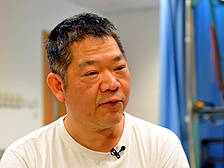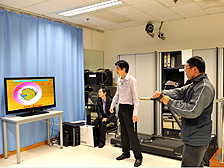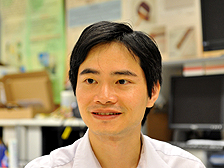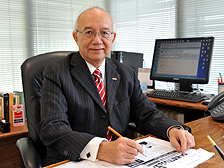
Ready for action:
Stroke patient Sam Chick’s motor ability has improved after taking part in the video-game-centred rehabilitation programme.

Perseverance pays:
Dung Wu-chuen (right) treasures every opportunity to regain his strength, and appreciates all that those involved have done to help him.

Compelling design:
Local elements in the games make them more enticing, Hong Kong Polytechnic University’s Associate Professor Raymond Tong, of the Department of Health Technology & Informatics, says.

Promoting inclusion:
Government Chief Information Officer Daniel Lai said nine projects have been sponsored to develop assistive devices to help the disabled to get access to online information and public services, and enhance their quality of life.
Video games aid stroke patients’ recovery
April 13, 2012
Canoeist Sam Chick’s hobby skimmed to a halt 12 years ago, in the wake of a debilitating stroke. It left him unable to move the left side of his body, including his arm and leg - and unable to paddle the light, slender, pointy-ended boat.
Like most stroke victims, there was no advance warning. He was not diabetic, did not suffer from heart disease, and had no family history of strokes.
“I suddenly fell down while playing with my daughter, and lost consciousness. My wife sent me to the hospital immediately,” Mr Chick said.
A stroke is a serious medical emergency that occurs when the blood supply to the brain is reduced or blocked, leading to a sudden lack of oxygen in the brain cells. Within minutes, the cells may be damaged - affecting body functions they control.
When a stroke victim’s condition stabilises, he must receive long-term rehabilitation to recover those functions.
Rising to video challenge
Mr Chick recently enrolled in a clinic at Hong Kong Polytechnic University’s Jockey Club Rehabilitation Engineering Centre. It has developed three video games played using a popular home video game sensor device that help patients regain their mobility in a fun and compelling way.
The university’s Associate Professor Raymond Tong, of the Department of Health Technology & Informatics, described how each game targets different motor functions.
“Good Views Hunting” aims to improve the ability to stretch one’s arms. Players imagine themselves sitting inside a ferry or a tram, and must continually clean the ‘dirty’ windows in front of them by moving their arms in front of the screen.
To keep them motivated, they are treated to ever-changing views of Victoria Harbour and old streets of Hong Kong.
“Hong Kong Chef” is a more difficult game that requires greater finesse, to improve the control of movements in their arms and hands. Players must prepare different local dishes, such as egg tarts and barbequed pork.
“They need to do a lot of hand functions - how to chop, how to pick up an ingredient and how to do the stirring - the kind of hand co-ordination motions that are needed in daily life,” Mr Tong said.
The game “Cockroach Invasion” trains patients to use their legs to stamp on cockroaches that appear at their feet on screen. Players can adjust the speed and numbers of cockroaches that appear, to suit their own ability. They must keep moving to step on the bugs, giving them an intensive workout while enhancing their ability to balance.
Self-motivated workouts
Mr Chick enjoys “Hong Kong Chef” the most, he says, because he loves to eat.
“It is also an intensive exercise session. I used to paddle a canoe. Now when I finish the game, I feel my body is hot and sweaty, the same feeling as having done intensive sports. Normal physiotherapy courses can be boring, since we just repeat the same actions in front of other patients. But through the games I can have more fun,” he said.
“If I perform well in the games, a ‘trophy’ will be shown on the screen. It brings back memories of winning medals in sports competitions in the past.”
The satisfaction compels Mr Chick to keep up the exercises. He realises he may never be as vigorous as before, but strives to improve day by day.
Progress tracked
An evaluation programme is included in the application, enabling the patients and their family and healthcare workers to track their progress. The application can also be adjusted to best suit the patient.
“In the initial stage, maybe his hand can just reach his eyebrow. Through the exercise and training, they can improve their range of motions. Maybe after 10 sessions, they can reach above their head,” Mr Tong said.
Stroke victim Dung Wu-chuen also enrolled in the programme, to try to regain function on the right side of his body, and to overcome difficulties speaking since the incident.
“I tried all the games and want to do better,” he said. “I couldn’t clean the windows at first because my arms were not strong enough. Now I can stretch my arms slowly.”
The training is intense, but Mr Dung will not give up. He treasures every opportunity to regain his strength, and appreciates all that those involved have done to help him.
“Every patient wants to recover fully,” he said. “The staff here are kind and help me a great deal. I need to work harder and not waste their effort.”
Promoting inclusion
This project is among nine projects the Office of the Government Chief Information Officer’s Development of Assistive Technology for Persons with Disabilities Fund has sponsored.
Government Chief Information Officer Daniel Lai said people with disabilities may find it difficult to use computers and information technology. Assistive devices can facilitate their access to online information and public services, and enhance their quality of life.
The office launched the fund in 2011 to support the development of assistive tools and applications. It has received 39 project proposals and selected nine of them, with a total funding value of $3.3 million. They include software development and upgrades, design of input and control assistance devices, web-based services, and rehabilitation tools.
The fund-supported projects will be completed in May. The office aims to make products derived from them widely available to the community at no cost.
An exhibition to be held from May 11 to 14 at Hong Kong Central Library will showcase the projects, and encourage the development of more such assistive tools and applications for people with disabilities.
To learn more about Polytechnic University’s rehabilitative video games, click
here.